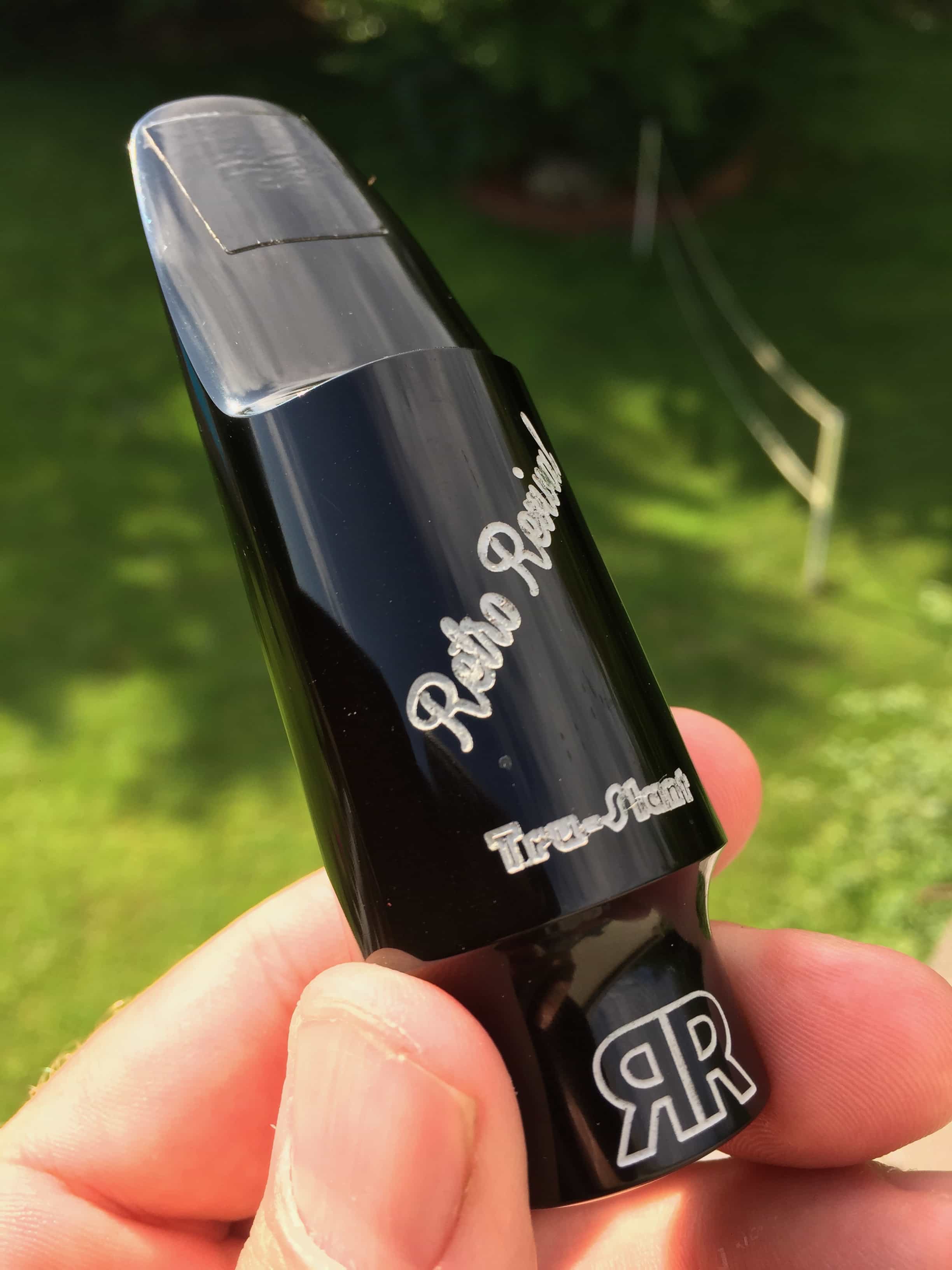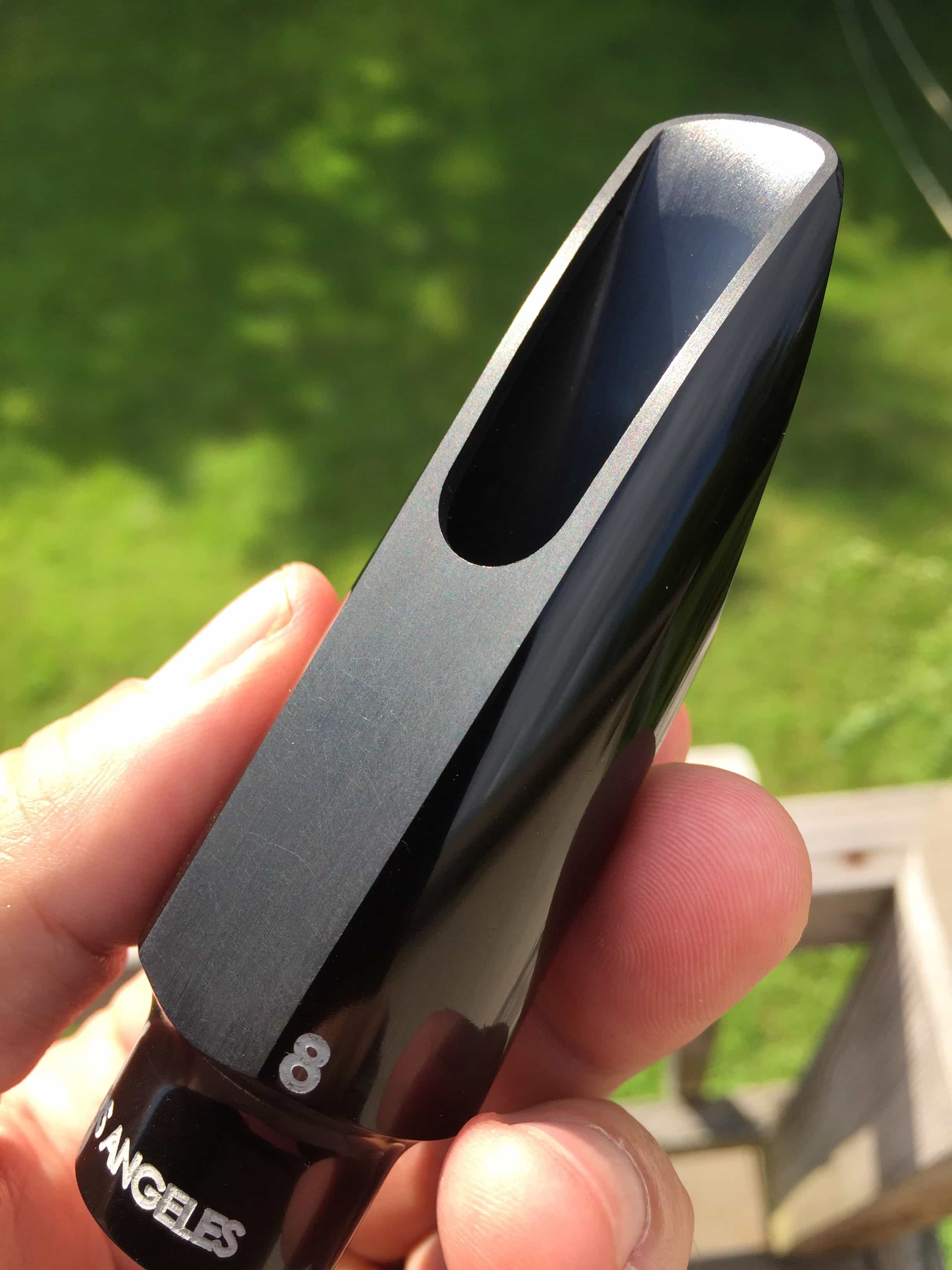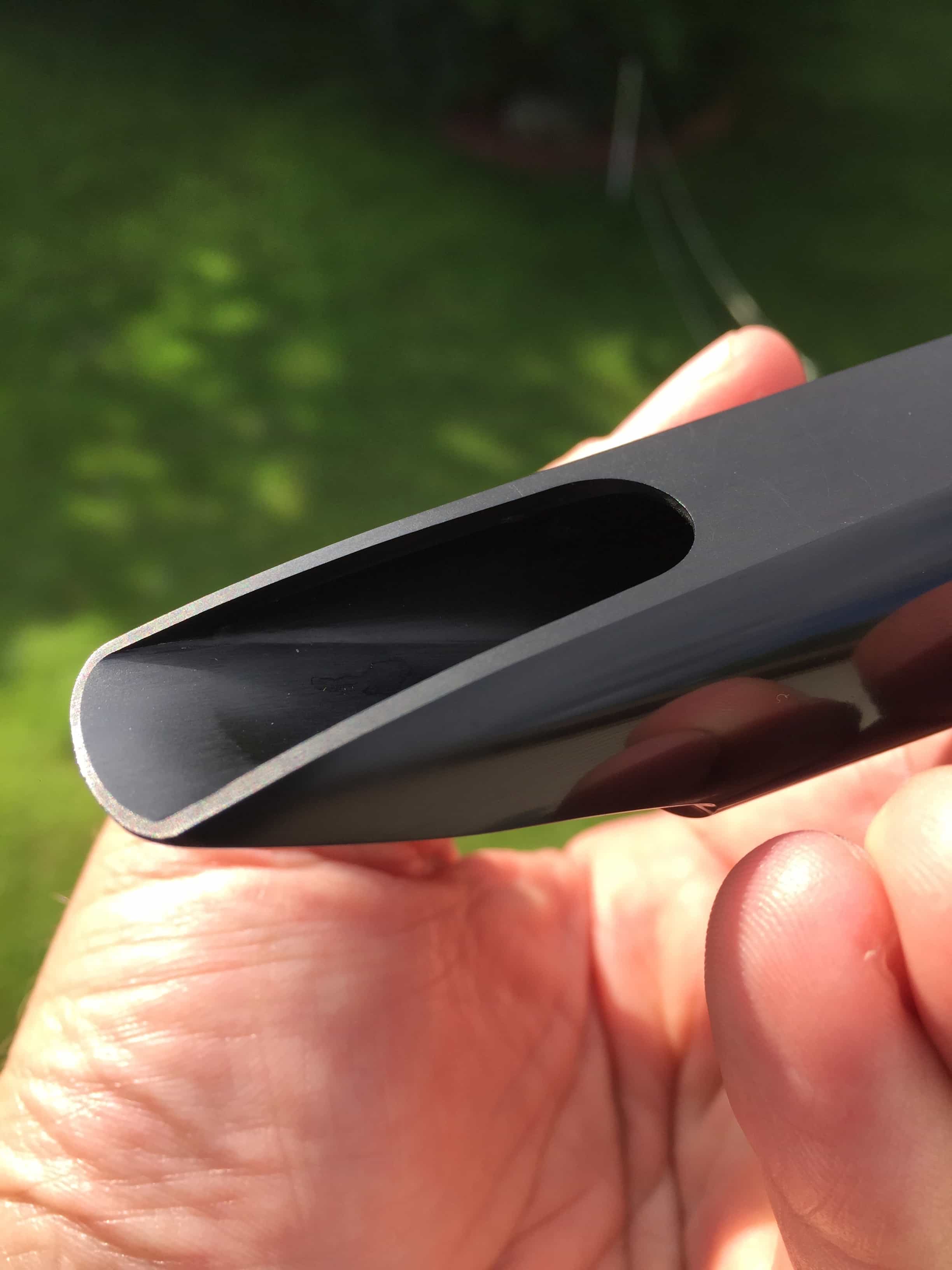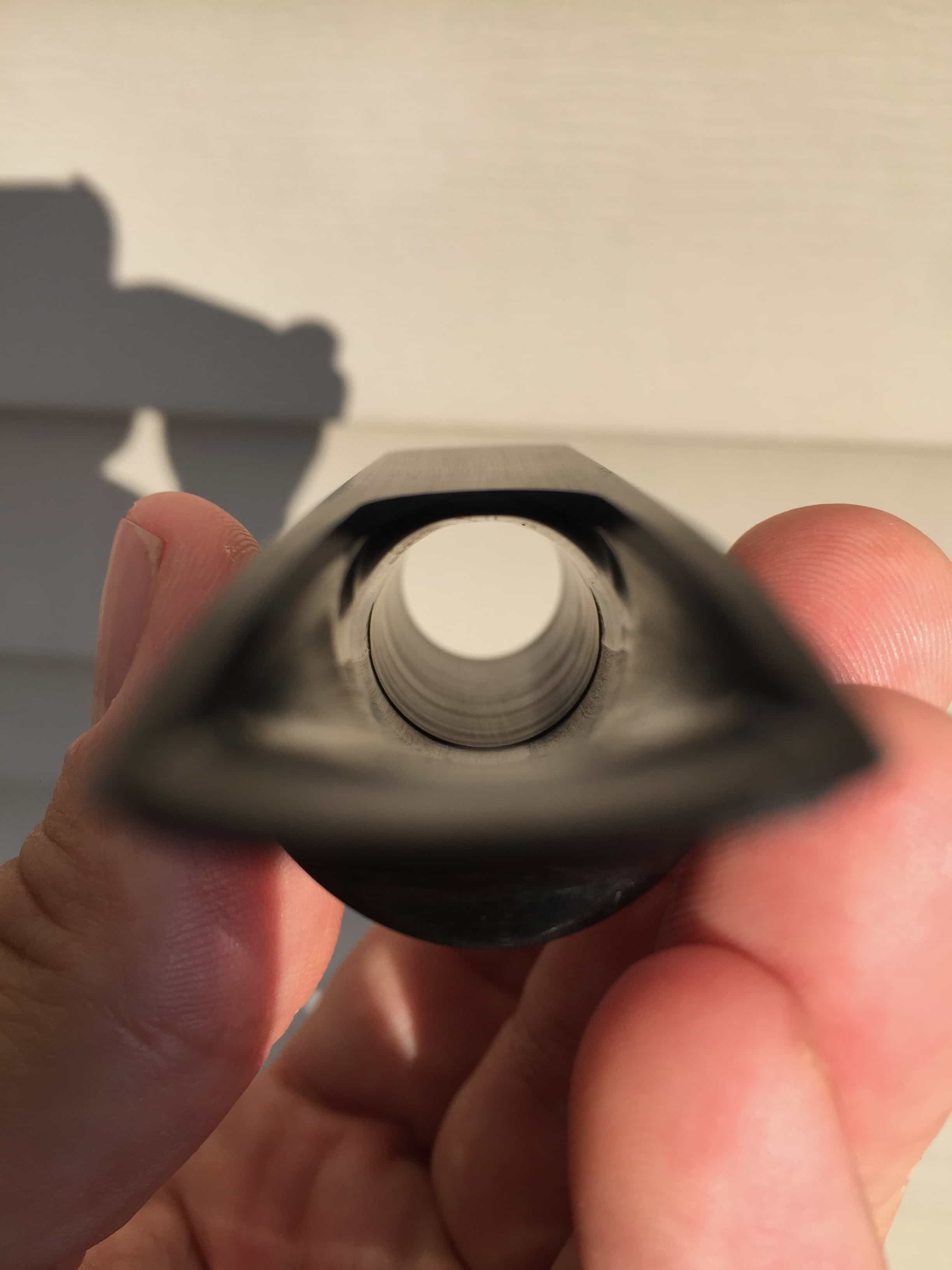Today, I am reviewing another Retro Revival tenor saxophone mouthpiece called the Tru-Slant. This is a tenor sax mouthpiece modeled after the Otto Link Slant Signature hard rubber tenor saxophone mouthpieces from the 60’s. These tenor saxophone mouthpieces are made by Joel Peskin (iReedMan) and Bob Sheppard at Retro Revival. In the past I have reviewed a few of the other Retro Revival sax mouthpiece models such as the Super D Florida tenor saxophone mouthpiece, the Super D New York tenor sax mouthpiece and the New Yorker alto saxophone mouthpiece.
Joel and Bob have started a company called Retro Revival in which they produce replicas of great vintage saxophone mouthpieces from the past. When Joel started the company they started with two sax mouthpieces. The New Yorker alto sax mouthpiece which is an exact copy of a New York Meyer Bros mouthpiece (that I reviewed last year) and the other was a metal tenor mouthpiece called the “Super D“,which is advertised as a replica of a great double ring Otto Link tenor mouthpiece. As of the writing of this review they now have seventeen different saxophone mouthpiece models available on their website. Wow! They have been busy!
Retro Revival Tru-Slant Tenor Saxophone Mouthpiece
For any of you that visit Ebay regularly, you probably know that finding an Otto Link Slant Signature tenor saxophone mouthpiece in good condition can be a costly endeavor. These saxophone mouthpieces can cost in the ballpark of 1200-2500 dollars depending on what condition it is in. I think we would all be thankful if someone came up with a less costly alternative where we could get a mouthpiece of the same quality and playability without going broke. The aim of these Retro Revival saxophone mouthpieces is just that!
Leading up to the creation of the Tru-Slant tenor sax mouthpiece, Joel says that Bob and he played through their collection of Slant Signature hard rubber Otto Links to find the absolute best one. Although this sounds like an arduous process, they came to an agreement about which Slant Signature to copy and then play tested each trial run to make sure it was what they were looking for. Both Joel Peskin and Bob Sheppard are great sax players in their own right so they knew what they were looking for. What they finally produced is the Tru-Slant tenor saxophone mouthpiece that I am reviewing today.
Retro Revival Tru-Slant Tenor Saxophone Mouthpiece
The Tru-Slant tenor saxophone mouthpiece came well packaged in a sturdy black cardboard tubing. The mouthpiece was in a velvet bag inside the tubing and was well protected. The tube itself was well packaged and protected in the shipping box it came in.
The first thing I did when I took it out of the box was to compare it to my Otto Link Straight Signature (Slant Blank) tenor mouthpiece. This is an Early Babbitt Straight Signature model with a large font tip opening number on the side. I have been told that these were made from the Slant Signature molds so they are basically a Slant Signature physically although they have a straight signature on them.
The two mouthpieces look very similar in shape when comparing side to side. The Otto Link has a slightly longer mid section and the beak profile looks a bit steeper than the Tru-Slant. They look to be a similar circumference but the Otto Link ahas a slightly wider rear circumference.
The inside of both mouthpieces looks remarkably similar. They both have that “Slant” clam shell baffle. Both baffles look to rollover in the same place. Both baffles look to descend into the chamber at the same angle when comparing by eye. The bore looks to be very close to the same size on both mouthpieces. The side rails are scooped out on both and look almost identical in shape.
The only slight difference that I see is that the baffle of the Retro Revival Tru Slant has what looks like two manufacturing lines that run down the length of the baffle and descend inward towards each other into the baffle. Although the Otto Link Slant blank I have does not have these lines, if you ignore the lines and just look at the actual shape of the baffle, sidewalls and chamber, they look very similar.
Retro Revival Tru-Slant Tenor Saxophone Mouthpiece
Here’s a quote from the Retro Revival website about the Retro Revival Tru Slant tenor saxophone mouthpiece:
Introducing the “True Slant” our newest replica from Retro Revival. The Otto Link “Tone Edge” Slant Signature tenor mouthpiece is one of the most sought after vintage tenor mouthpiece’s and now Retro Revival has brought it back to life. Like all of our Retro Revival replica’s, the “True Slant” is CnC milled and Precision Finished from the highest quality German bar rubber. This mouthpiece is a joy to play; articulate, colorful, the real thing ! We made sure our “True Slant” has all the special qualities of an original Tone Edge “Slant Signature”.
The history of the Tone Edge spans decades. In the late 1950’s when Otto Link created the “Tone Edge” back in New York, it quickly became the gold standard for the greatest players. The original Tone Edge made in New York had a larger chamber, closer tip openings, only available up to #6 which was stamped on the table. After Otto Link moved to Florida changes took place. ( The tip size stamped on the right side of the table and the Otto Link logo engraved on a 45 degree angle)
This signature angle became the identifying feature that people now refer to as a “Slant Signature”. This Florida model had a higher rollover baffle and tip sizes were available from 5 to 9. This Florida version of the Tone Edge was a true masterpiece and was very popular for many years. When Otto Link re-located to Elkhart IN with their remaining mouthpiece blanks and tooling, the Tone Edge remained excellent for some time, but something happened to the quality and playability. The “Tone Edge” lost its mojo, most likely due to quality control and changes in manufacturing. Our ”True-Slant” is a recreation of the best version of the “Slant” from the good old days. We went through pains taking efforts, play testing many versions of the Tone Edge from our combined collections. We feel very confident that our “True-Slant” is the best replica on the market, offering tip openings ranging from 6-8*. Of course, each and every Retro Revival mouthpiece is play tested to our highest standards.
So, if you’ve been searching high and low for a “Tone Edge, Slant Signature” that really performs from the softest PPP dynamic to the loudest FFF dynamic in the flip of a millisecond with effortless altissimo, our “True Slant” is what you’ve been searching for.
Retro Revival Tru-Slant Tenor Saxophone Mouthpiece
With caring precision, the process of replication starts with hand drawings, precisely measuring every parameter, translating these numbers into computer code to produce 3D images, then CNC milled in one piece from the highest quality bar brass. Each mouthpiece is then hand faced, and most importantly play tested before polishing.
At Retro Revival, our cumulative life experience as top professionals in the LA studio’s and concert stages around the globe has informed our passion for great equipment. Having practical insight into the variables and complexities of mouthpiece set ups has been a constant learning process. Even from a young age, searching, comparing and experimenting with mouthpieces, reeds and ligatures, trying to emulate the beautiful sounds of our hero’s on the records, this fascination with personal sound production and approach still continues. Informed by the demands of the gig and always paying close attention to great players with beautiful tone, Retro Revival is a natural extension to our musical path’s. There is a good reason why the greatest Legends of jazz and contemporary music played Links, Meyers, Bergs, etc.
It is our intention to earn your trust by offering the real deal. No hype, exaggerated claims and cliche sales gimmickry. Our intended goal is to offer affordable vintage replica mouthpieces that we would actually use and love to play ! To our highest standards, we are committed to play testing every mouthpiece, and with great pride, we are confident that sax players from every age and level of experience will feel and hear the special qualities of all of our sax mouthpiece.”
Retro Revival Tru-Slant Tenor Saxophone Mouthpiece
This Retro Revival Tru-Slant tenor sax mouthpiece has an 8 tip opening which is a .110. It played very well for me with a Rigotti Gold 3 Light reed as well as a Rigotti Gold 2 1/2 Strong reed. The 2 1/2 Rigotti reeds felt a little soft for my preference but some people might like the sound and playability of a softer saxophone reed so I included a sound clip of each for you to check out.
The 3 Light Rigotti reed had a husky thick tone to it that had a lot of character and texture to the tone. The intonation was great and the tone was even throughout the range of the horn. The Rigotti 2 1/2 Strong reed seemed less complex than the tone of the 3 Light reed to my ears. It is almost like the harder reed provided more overtones and layers to the sound. I did like the altissimo with the softer Rigotti 2 1/2 Strong reed though (you can hear this at the 2:06 mark of the 2 1/2 reed sound clip)
Retro Revival Tru-Slant Tenor Saxophone Mouthpiece
Like my Otto Link EB Slant Blank tenor mouthpiece, I probably wouldn’t take the Retro Revival Tru-Slant out to a really loud R&B or rock gig just because I find that in those situation I need a brighter more focused sound to cut through the loud mix but the Tru-Slant would be a killer mouthpiece for jazz gigs or medium loud gigs of all kinds.
I have discussed how it looks very similar to my Otto Link EB Slant Blank mouthpiece above but I think it sounds similar also. I played the Tru-Slant and my EB Otto Link side by side and they sounded fairly similar in tone to my ears. When using the same reed on both mouthpieces the EB Otto Link was slightly brighter I think that is primarily because the EB Otto Link mouthpiece is a 7* and the Retro Revival Tru-Slant is an 8 tip opening.
Retro Revival Tru-Slant Tenor Saxophone Mouthpiece
Both sound clips below have similar elements in each clip. If you go back and forth between the clips where I play the same lines, I think you can hear the difference between the reeds I chose for each clip. I start out both clips with the A section to “I Hear a Rhapsody” so if you want to compare the tone difference because of the reeds you can compare that melody to get an idea.
Retro Revival Tru-Slant Tenor Saxophone Mouthpiece
The Retro Revival Tru-Slant tenor saxophone mouthpiece is a great playing mouthpiece! It has a depth of character and rich thickness to the tone that makes it sound great for jazz playing. If you read this review, listen to the clips and decide the Tru-Slant tenor mouthpiece is worth a try, you can purchase one on the Retro Revival website.
Congratulations to Joel Peskin and Bob Sheppard for making an excellent well crafted mouthpiece reminiscent of a great vintage Otto Link Slant Signature tone master tenor saxophone mouthpiece! Great Job!
Let me know your thoughts in the comments below and if you get a Retro Revival Tru-Slant tenor saxophone mouthpiece be sure to come back and let us know what you think below……..Thanks!!
Retro Revival Tru-Slant Tenor Saxophone Mouthpiece-Rigotti Gold 3 Light Reed Reed
Retro Revival Tru-Slant Tenor Saxophone Mouthpiece-Rigotti Gold 2 1/2 Strong Reed











What horn do they test these mouthpieces on? Sure sounds great on your Selmer, and I expect it was tested on a Selmer.
I am assuming Selmer Mark VI’s and SBAs. I know Bob Sheppard plays Selmers from the photos I have seen. Steve
Steve: I think that the 2.5 strong speaks faster and seems easier to play for you than the 3.0 light reed. It seems like you are having more fun playing the 2.5 strong reed.
I have one of these mcps in an 8* HR. However the sound seems covered. I may send it to Brian Powell to see what he can do about opening the sound up some.
I definitely prefer my FL metal Otto Link 8* from the mid – 60’s on tenor. However thanks for reviewing this mouthpiece. To let your readers know. If you buy a Retro Revival mouthpiece you own it. They will not take it back if you think it doesn’t work for you. So that is a down side to dealing w/these guys.
Thanks Larry. Although there are a few companies that will take returns, I think the majority of mouthpiece companies do not take returns on mouthpieces. Now that I think about it, it’s probably rare to take returns on a product customers stick in their mouth for many hours. Maybe they do, I have never tried to return a tooth brush after using it for a week so I’m not sure about that one….
P.S. What do you mean by the term “covered”? I don’t think I have heard that term before in describing a mouthpiece…. Thanks, Steve
Hi Steve,
How does this compare to a 10mfan Merlot?
Thanks
Seems very full and very solid. Nice warm sound.
Seems like it is a very flexible mouthpiece that could cover jazz as well as contemporary R&B,funk styles.
The 3 Light Rigotti Reed, has a slightly punchier attack.
Anyways,as always ,it is a pleasure to hear you on these well made mouthpieces made by my Los Angeles talented colleagues and friends , Joel Peskin & Bob Sheppard
I read on the Retro Revival website:
“… The original Tone Edge made in New York had a larger chamber, closer tip openings, only available up to #6 which was stamped on the table…”
“…”Slant Signature”. This Florida model had a higher rollover baffle and tip sizes were available from 5 to 9… “.
And then I read:
“ … We feel very confident that our “True-Slant” is the best replica on the market, offering tip openings ranging from 6-8*… “.
Shouldn’t the best replica on the market, perhaps I mistake, like the original, have tip openings from 5 to 9?
Giuseppe.
I assume Retro Revival is basing their tip sizes on the most popular tips now a days. The 5’s and 9’s don’t sell anywhere close to the 6-8* tip openings from what I understand.
Steve, I understand the laws of the market that want the most used and therefore the best selling openings to be produced today but if, for LOGIC, we love the sound that “the musicians of that era”, “using the mouthpieces of that era”, that ” had the tip openings of that era “, that is: ” … closer tip openings, available only up to n.6 … “, I wonder why, always FOR LOGIC, we should make a “copy” of those mouthpieces, however with different tip openings which, probably, for these different tip openings, will give a “different” sound from the one we love to listen to that of the musicians of that time?
So maybe I can make a mistake but, if we love a sound different from what came from the musicians “and from the mouthpieces with the tip opening of that era”, we could use a new mouthpiece model, more suited to the sound that we prefer today, instead of using the copy of a vintage mouthpiece, however with a bigger tip opening that, probably, for this difference, it will give a different sound to those of the time …
Am I wrong?
Giuseppe.
Excuse my english.
Giuseppe, I understand what you are saying. I just personally have no use for mouthpieces that are a 5 tip opening for tenor. I suppose it would be fine at home but in the real world where I have to play out with electronic instruments, I have been unable to get a tip opening that small to give me the projection and volume I need to be heard. I think that is the reality of the electronic world and why tip opening started creeping higher after electronic instruments starting becoming more and more popular. Sax players just needed to put more air through the horn in order to be heard. There are always purists that argue with me on this point and say they can play every gig on a 5 tip opening. That has not been my experience though.
I do believe the RS Berkeley mouthpieces are copied and made in the same tip openings as the originals. Like the Stan Getz model I think was a 5* if I am not mistaken. Steve
Hi Steve, thank you for your honest and objective response and for your reference to RS Berkeley mouthpieces.
I also understand the problem that a professional must play very loudly as volume to cut electronic instruments (but can’t you turn up the volume of the sax microphone?); I have the reverse problem since I live in a condominium! If I play too loud I worry.
I remember, in the 70s, my sax teacher Larry Dinwuiddie from New York who, trying a student metal Ottolink 5, said: “it is not possible to go under 6.” Being a student I didn’t tell him that, instead, the sound of that 5, played by him, I liked perhaps more than that of his Ottolink 7 *. A student always thinks he is wrong. True, the high notes were very fine but the sound was beautiful.
However, I see some American professionals saxophonists, on the internet, with Navarro mouthpieces, who use tip opening 5 and 5 * and their sound is beautiful.
However, if nobody sells well-made lower measures of tip opening, it is clear that nobody can buy them and understand how, at times, they perhaps sound even better than the big ones; and, therefore, there cannot even be the commercial demand for mouthpieces in these measures, and the logic returns: “the bigger the tip opening, the more professional and better the sound”.
If I can only buy a commercial inexpensive product, often “finished” as we know, it is clear that I am not satisfied!
These saxophonists are Mr. Walt Weiskopf , metal Maestra Navarro 5, https://www.youtube.com/watch?v=d4CzI4dvGss
and Mr. Bob Bowlby Maestra Navarro 5*
https://www.youtube.com/watch?v=hOHqeLKUdsU
Giuseppe.
I have a mouthpiece of this 7 *, signed by Eric Falcon. I don’t know if he still works for Retro Revival. But I can say that this piece is particularly great. They deliver everything they promise. I usually use Rico Select Jazz 3S or 3M reeds, unfiled. The answer is excellent. His observations were very accurate and I share his impressions. Continue with the excellent work. Big hug